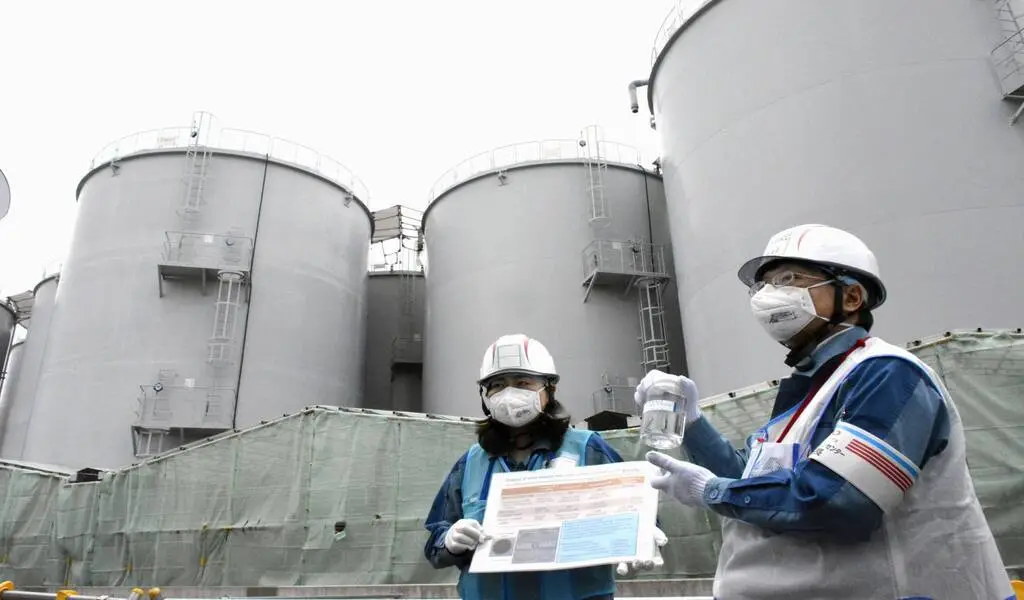(CTN NEWS) – Japan has announced its intention to commence the release of over 1 million metric tonnes of treated radioactive water from the Fukushima nuclear power plant’s afflicted site on August 24th.
This decision is being carried out despite apprehensions expressed by neighboring countries such as China, as well as concerns from local fishing communities.
The initiative, which was greenlit by the Japanese government two years ago, is considered indispensable for the overall process of dismantling the nuclear power facility. The plant had suffered extensive damage due to the devastating tsunami that struck in March 2011.
The water, initially employed to cool the reactors, has been stored on-site since the catastrophe occurred, and Tokyo Electric Power Co (Tepco), the plant’s operator, is running out of space to accommodate it.
Prime Minister Fumio Kishida conveyed on Tuesday that he had urged Tepco to expedite preparations for the water discharge, with an anticipated commencement of the release on August 24th, weather conditions permitting.
Japan’s Water Release Safety Confirmed Amidst International Perspectives
Japan has affirmed the safety of the water release, a stance endorsed by the International Atomic Energy Agency (IAEA).
Following an inspection in July, the United Nations’ nuclear oversight body granted approval to the scheme, citing its alignment with international standards and its minimal impact on both people and the environment.
However, certain neighboring countries, particularly China, have cast doubts on the safety of the plan. Wang Wenbin, the spokesperson for China’s foreign ministry, stated in July that Japan had exhibited self-centeredness and hubris.
China contended that Japan had not adequately engaged with the global community regarding the water release.
While South Korean activists have protested against the plan, the government in Seoul has conducted an independent study and determined that the water release conforms to international norms. It also acknowledged the IAEA’s evaluation.
Seoul announced on Tuesday that the proposal presented no scientific or technical concerns. However, this acknowledgment does not necessarily translate into endorsement.
The volume of water, equivalent to more than 500 Olympic-sized swimming pools, encompasses groundwater and rain that have permeated the storage containers.
Although the water has undergone dilution and filtration to eliminate radioactive elements, small traces of tritium, a hydrogen isotope that proves challenging to separate from water, persist.
Tepco asserts that the water will be further diluted to levels well below internationally approved tritium thresholds prior to its release into the Pacific Ocean.
Scheduled Ocean Discharge of Fukushima Water Sparks Concerns
The water is scheduled to be discharged into the ocean off Japan’s northeastern coastline, with a maximum release rate of 500,000 liters (approximately 110,000 gallons) per day.
Greenpeace, an environmental advocacy group, has criticized the filtration process, asserting that it is flawed and warning of a significant amount of radioactive material being dispersed into the sea in the coming decades.
However, Tony Hooker, a nuclear expert affiliated with the University of Adelaide in Australia, dismissed this argument as “fear-mongering.”
He highlighted that the release of tritium from nuclear power plants has been ongoing for many decades without any substantiated detrimental environmental or health impacts. Hooker conveyed this perspective to the AFP news agency.
China Implements Ban on Seafood Imports from Fukushima and Tokyo Prefectures
China has imposed a ban on seafood imports from 10 prefectures in Japan, including Fukushima and the capital city, Tokyo.
While seafood imports from other prefectures are permitted, they must undergo radioactivity testing and provide evidence of being sourced from outside the restricted 10 prefectures.
Hong Kong, the second-largest market for Japanese seafood exports following China, criticized the water release as “irresponsible.” The city announced its intention to implement import controls in order to safeguard food safety and public health.
Hong Kong Chief Executive John Lee expressed concerns about the “unmanageable risks to food safety” and the irreversible pollution and damage to the marine environment in a Facebook post.
In South Korea, apprehensions are also widespread, with hundreds of individuals gathering in Seoul earlier this month to express their opposition to the water release plan.
This sentiment is shared by individuals in Japan’s fishing sector, which had been gradually recovering more than a decade after the nuclear catastrophe occurred.
Haruo Ono, a third-generation fisherman, emphasized the lack of benefits from the water release for their industry.
Ono, whose brother tragically lost his life in 2011, stated to AFP in Shinchimachi, located 60 kilometers (40 miles) north of the nuclear plant, that the water release plan brings no advantages to them.
According to James Brady of Teneo risk consultancy, China’s apprehensions regarding safety might indeed be genuine, yet there seems to be an undertone of geopolitical maneuvering and economic competition in its reaction.
Brady pointed out that the complexity of the matter surrounding the release of Fukushima wastewater makes it a strategically advantageous issue for Beijing to possibly capitalize on.
He mentioned that Beijing could use it as a means to apply economic pressure along the trade axis, amplify internal political divisions within Japan regarding the matter, and even potentially influence the progress of diplomatic relations between Seoul and Tokyo.
RELATED CTN NEWS:
Thai’s Ex-PM Thaksin Shinawatra Returns To Thailand And Begins 8-Year Prison Term
Thailand Inks Mini-Free Trade Deal With China’s Yunnan Province To Enhance Collaboration








